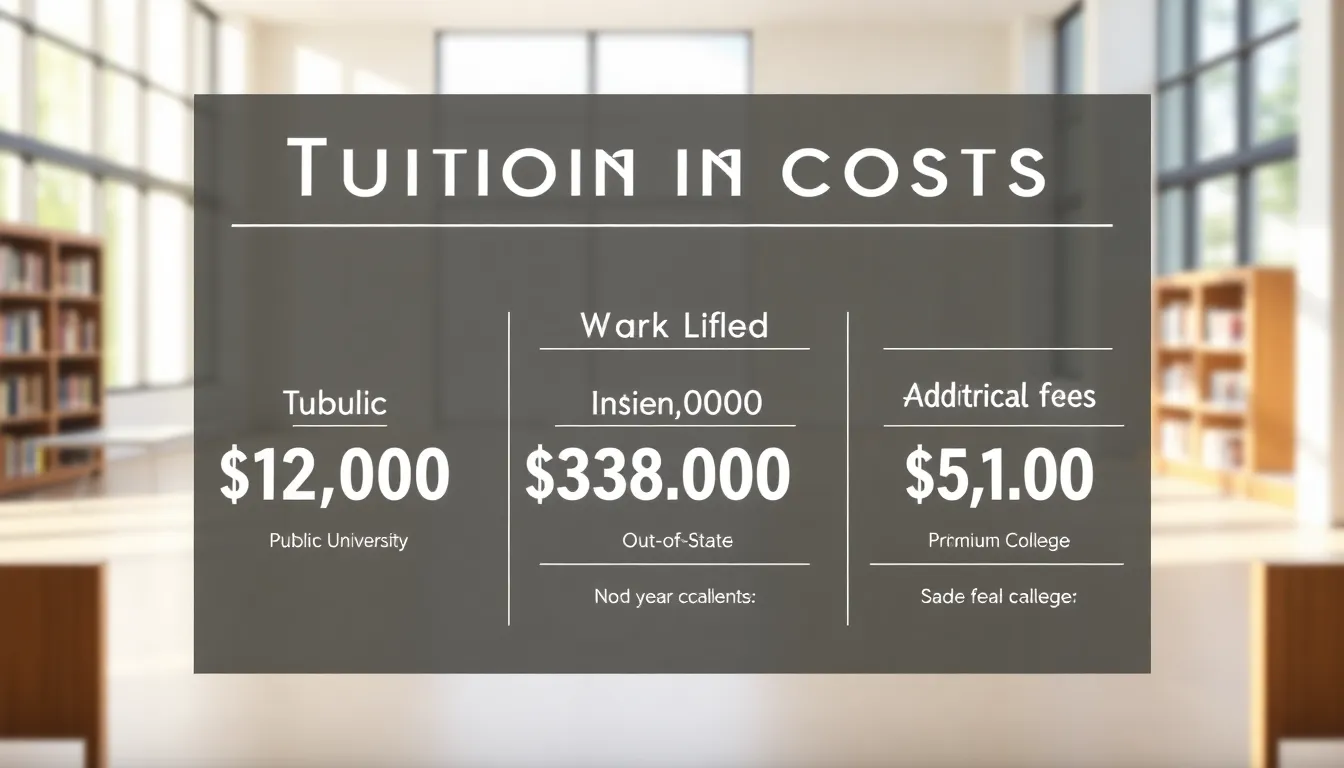Table of Contents
ToggleHave you checked those tuition bills lately? If you haven’t, you might want to sit down because Washington college tuition is a topic that can make anyone’s wallet feel light. Jokes aside, understanding how much college costs and where that money really goes can be quite enlightening, especially if you’re a parent, student, or just someone who enjoys riveting discussions about finances. With the right intel, saving on tuition might just turn from improbable to possible.
Overview Of Washington College Tuition Costs

Washington college tuition costs can seem overwhelming at first glance. For the 2023-2024 academic year, the tuition rates vary significantly among different institutions. Public universities, like the University of Washington, charge in-state students approximately $12,000 per year, while out-of-state students might pay around $38,000. On the other hand, private colleges can go even higher, with costs reaching up to $60,000 or more annually.
Tuition is just one piece of the puzzle. Students should also consider additional fees, like student activity fees, lab fees, and health insurance, which can add several thousand dollars to the overall cost of attending college in Washington. Besides, books and supplies can easily tack on another $1,000 to $1,500 each year.
With these costs in mind, it’s essential for students and families to do thorough research, looking beyond just the tuition sticker price.
Factors Affecting Tuition Rates
Several factors influence tuition rates at Washington colleges and universities. One major consideration is whether the institution is public or private. Public universities often receive state funding, which can help keep costs lower for in-state residents. Conversely, private institutions rely more on tuition revenue, which can skyrocket.
Another key factor is geographic location. Colleges situated in urban areas often have higher operating costs, leading to increased tuition. Also, brand reputation and the programs offered play significant roles. Institutions with prestigious programs or high graduation rates typically charge premium rates.
Finally, ongoing inflation impacts operating costs for colleges, which can trickle down to students in the form of increased tuition. Keeping these dynamics in mind can help prospective students evaluate what they’re willing to pay for their education.
Financial Aid Options For Washington College Students
Financial aid can be a game-changer for many students navigating the tuition landscape. Washington colleges offer various financial aid options to help reduce the financial burden. Students can apply for federal aid through the FAFSA, which can open doors to federal grants, work-study opportunities, and low-interest loans.
State-funded programs, like the Washington College Grant, provide additional assistance to eligible students. This program can cover a substantial portion of tuition costs, sometimes even the full amount, depending on income levels.
Scholarships are another avenue worth exploring. Numerous private organizations and foundations offer scholarships based on merit, need, or specific criteria like community service. With diligent research, students can find financial support that alleviates some of the financial stress associated with tuition.
Comparing Public vs. Private Institutions
When deciding between public and private institutions, it’s crucial to weigh the pros and cons of each. Public universities, benefiting from state funding, often have lower tuition rates, especially for in-state students. They also tend to offer a broader range of programs and larger student populations.
On the flip side, private colleges might offer smaller class sizes and potentially more tailored programs. But, they generally come with a higher price tag. Students should assess not only the tuition but also what each institution offers. For instance, some private schools might include amenities that enhance the educational experience, such as more robust career services or dedicated faculty.
Eventually, students should align their choice with their career goals, preferred learning styles, and financial situations.
Living Expenses And Additional Fees
Tuition isn’t the only expense students encounter while attending college. Living expenses should be factored into the overall budget, as they can vary widely based on location and lifestyle. In cities like Seattle, the cost of living can be substantially higher than in smaller towns, leading to accommodation costs that might make one’s eyes water.
Other additional fees might include health insurance, transportation, and meal plans. On average, students should expect to spend around $15,000 per year on living expenses in Washington. Combined with tuition, these figures can bring the total annual cost close to $30,000 or even higher, depending on individual circumstances.
Strategies To Manage Tuition Costs
Managing tuition costs requires a multifaceted approach. First off, prospective students should apply to multiple colleges to compare financial aid packages. Shopping around could save thousands in tuition.
Considering community college for the first two years is another smart strategy. Washington’s community colleges are known for their quality education and lower costs, allowing students to transfer to a four-year institution later.
Also, students should take advantage of work-study programs and on-campus job opportunities. These can help offset living expenses while providing valuable work experience. Finally, keeping track of deadlines for scholarships and financial aid applications is crucial to maximize available funding options.




